The
collection is unusual in that all of the signatures are on
one
vintage Stetson cowboy hat - on the crown, on the brim,
and even under
the brim. The signatures, executed by fountain pens
(this was
before the days of ballpoints), virtually all date from
the 1928-1936
time
period. I immediately thought of it as "The
Hollywood Hat."
This was an
interesting era in Hollywood history. In the late
20's, the
Academy of Motion Picture Arts and Sciences was founded,
Grauman's
Chinese Theater started collecting foot and handprints,
WAMPAS Baby
Stars were all the rage and movies went from silent to
"talkies." As I researched the names on the hat, I
came to
realize how the switch to talking pictures affected many
of the hat's
signers. Like fictional George Valentin in "The
Artist," lots
of big-time careers crashed with the advent of sound,
including these
hat signers - Eleanor Boardman, Norman Kerry, Pauline
Starke, Antonio
Moreno, Victor
Varconi, Aileen Pringle, and most famously, John Gilbert.
 John
Gilbert
John
Gilbert
 Eleanor
Boardman
Eleanor
Boardman
 Antonio
Moreno
Antonio
Moreno
WHOSE
HAT
WAS THIS?
But the first question on my mind was "Whose hat was
this?" I
came up with what we can call Theory #1.
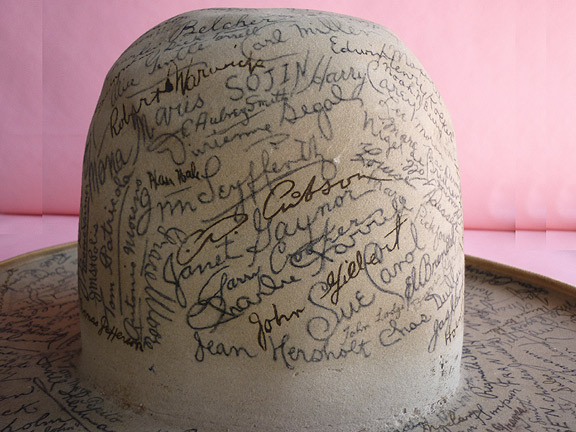
Theory #1: The Stetson hat was worn by one very
dedicated
autograph collector who spent years haunting Hollywood
Boulevard. The doorman at the Brown Derby probably
knew him
on sight. And what a great gimmick. Rather
than
shoving pen and paper at a movie star, ask them to sign
a ten gallon
cowboy hat. Who could resist? Judging by the
sheer
number
of signatures, no one.
As I made a list of every name on the hat, it slowly
dawned on me that
quite a few of the signers were contract players at
M-G-M and, to a
lesser extent, at Fox, the two studios on the West Side
of Los
Angeles. There's hardly anyone from Warner
Brothers,
Paramount
or RKO, all located on the other side of town.
I decided to vote Theory #1 off the island, and
developed Theory #2.
Theory #2: The dedicated autograph collector hung
out at the
front gates of M-G-M and Fox, which are conveniently
connected by a
winding street called Motor Avenue. Local lore is
that Motor
Avenue was built to cut down on the commute time between
the two
studios; it only takes about 10 minutes to toodle up or
down Motor
Avenue.
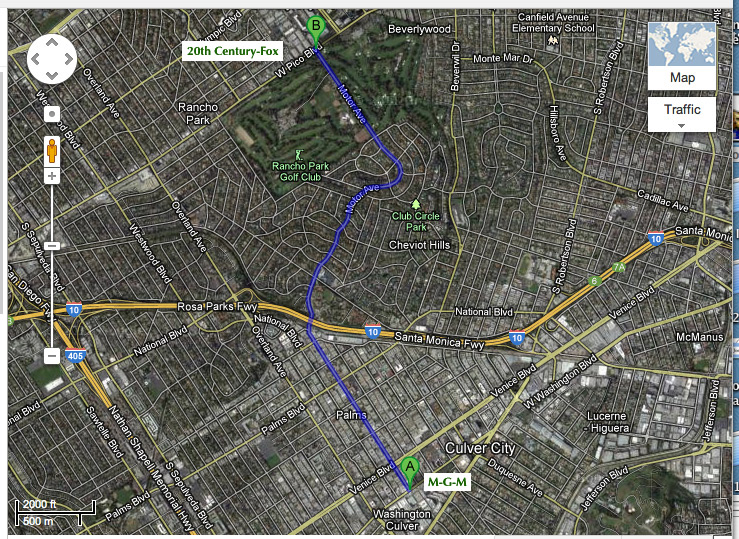 Motor Avenue
connects M-G-M and 20th-Century Fox
Motor Avenue
connects M-G-M and 20th-Century Fox
But then I started spotting autographs of directors
(unless they're
Spielberg or Hitchcock, who the hell asks a director for
his
autograph?) - King Vidor, W.S. Van Dyke, Roy Del Ruth,
Robert Z.
Leonard, Thornton Friedland, Alfred E. Green, Archie
Mayo, Eddie
Buzzell. And
I thought,
okay, it's time to tool up Theory #3.
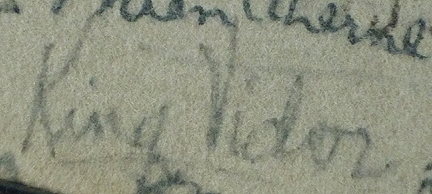
King Vidor
|

W. S. Van Dyke
|
Theory #3: This hat belonged to an insider -
someone who had
frequent access to the two studios. Maybe they
were an extra
or maybe the hat belonged to a movie crew member. The
only thing
working against Theory #3 is an immutable law of
Hollywood once behind
the studio walls - don't bother the stars.
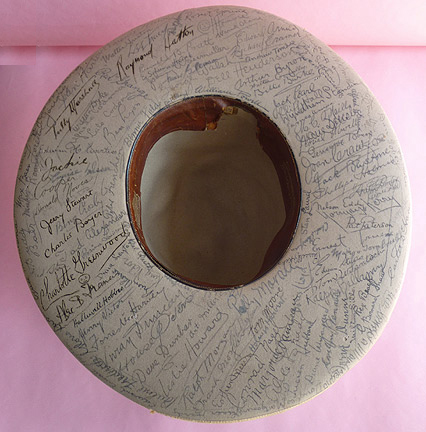
The hat is a crazy quilt of
signatures, and I kept seeing new
names. On the underbrim, I was stopped cold by the
signature
of British playwright G. Bernard Shaw. What on
earth is the
signature of George Bernard Shaw doing on this
hat? I know
Shaw visited Hollywood in his lifetime.
Once. In
1933. For just three hours.
 George Bernard Shaw
George Bernard Shaw
I asked myself
again: Whose hat was this?
Over 90 per cent of the names on the Stetson were actors
and actresses
plus the aforementioned directors as well as a gaggle of
World
Heavyweight Boxing Champions (more about them
later). And
then, in the midst of all this celebrated celebrity,
there were the
"John Hancocks" of four men who worked in studio make-up
departments. No set designers. No costume
designers. No sound recorders or music
arrangers.
Just four make-up men. Curious.
Theory #4: The hat belonged to someone in the
make-up
department at M-G-M or Fox. Make-up people would
have daily
access to stars at their most relaxed and vulnerable,
when they're just
sitting there with nothing better to do than autograph a
cowboy hat.
The four make-up artists who signed the hat were:
Jack Dawn,
who led M-G-M's Make-Up Department from 1935 to 1950,
and who is best
known for his ground-breaking work on "The Wizard of
Oz";
Ward Hamilton with a raft of credits for Errol Flynn
movies at Warner
Brothers; Blagoe "Bob" Stephanoff, who worked on such
Samuel Goldwyn
classics as "Wuthering Heights" and "The Best Years of
Our
Lives"; and Cecil Holland, a silent screen
character actor
who started the first big studio make-up department in
1925 at
newly-formed M-G-M. Unfortunately, there's no
chance to ask
them if they remember signing the hat; all four men
passed on many
decades ago.
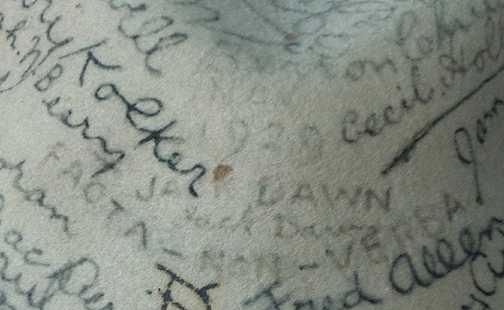
Jack Dawn
|

Ward Hamilton
|

Bob Stephanoff
|

Cecil Holland
|
An
Eyebrow
is Born - Testing eyebrows -- and the "Crawford
Smear" --
on Janet
Gaynor in 1937's "A Star is Born." One of the
best movie
make-up department scenes -- ever.
 Janet Gaynor
Janet Gaynor
So, I've got a hat filled with
autographs from the 1928-1936 time period, which was
originally
situated (maybe) in the M-G-M and Fox make-up
departments.
Only three people who signed the hat are still alive -
Shirley Temple,
Mickey Rooney and Jackie Cooper.

Shirley Temple

Mickey Rooney
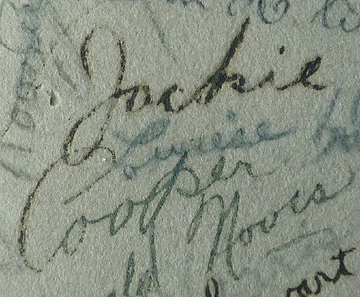
Jackie Cooper
ALWAYS
CHECK
THE OBITUARIES
As I'm pondering how to
proceed in unlocking the provenance of the hat, I read
in the LA Times
that Jackie Cooper just died. Oops. Make
that two
people still alive. And honestly, Mickey and
Shirley must
have had seriously wackadoodle childhoods. Rooney,
born in
1920, had been in movies since the age of 6, racking up
over 40 screen
credits by the time he was 10. As for Temple, an
actor once
told me of being on the Fox lot in the 1930s and as he
walked by
Shirley's bungalow, he could see her outside, marching
in a circle
repeating to herself: "I am Jesus. I am
Jesus." I'm not accusing Shirley of a
son-of-god-like ego (by
all accounts, she grew up to be grounded and "normal");
it's likely
that she was just repeating something an adult said in
her presence
(probably with a cigar dangling from the corner of his
mouth): "The kid is as big as Jesus!"
Like I said - wackadoodle childhoods. Temple was
the number
one box office star from 1935-1938; Rooney was number
one from 1939 to
1941. Autographing a cowboy hat wouldn't be in
either
Mickey's or Shirley's top 100 memories during their kid
stardom.
(I wrote to Temple and Rooney, but never got a
reply.)
I did some
research on early studio
make-up departments. And
I found out… almost nothing. Hardly any movies
have make-up
credits during the 20's and 30's and the bios I find of
Dawn, Hamilton,
Stephanoff and Holland are brief. There is a
mention that
Holland had a daughter, Margaret, born in 1927, who
excelled as a portrait artist. I find out,
amazingly, she's
still active with a website. Just before I left
for a
vacation in Italy, I emailed her an inquiry in the
slimmest,
off-chance, Hail-Mary-pass kind of way, asking if she
remembered going
to her Dad's "office" when she was a very little girl
and seeing a
beige cowboy hat covered with movie star signatures
somewhere in the
M-G-M Make-up Department. We all have odd memories
from our
childhoods, and I hoped the hat was one of hers.
Several days
later, I'm in an internet cafe in Rome plowing through
some business
emails when I see Ms. Sargent has replied. I open
up the
email and read:
"Dear
Mr. Blitman,
I
was delighted to receive your email
with a request for information about the
cowboy
hat. You have reached
the right person for
its background. It was my father,
Cecil Holland, who got all those
signatures from the
actors who sat in his makeup chair… many of whom later
became friends
… It was his
pride and joy."
Bingo. Eureka.
Supercalifragilisticexpialidocious. Cecil Holland
didn't just
sign the hat. He owned
the hat. Suddenly, just like
that, there's divine provenance.
How do you say "I'm doing the happy dance" in
Italian? I have
no idea, but I do know I spent the day exploring the
Colosseum with my
thoughts binging and boinging like a pinball machine
with alternating
visions of Christians, gladiators, and lions and
Joan Crawford
being
made up for "Our Dancing Daughters."
CECIL WHO?
Los Angeles has always attracted
certain men and women whose dreams and
abilities are on steroids, and to whom no 9-to-5 job can
do
justice. These people are larger-than-life in some
respects,
and need to exist outside the box in order to
flourish. They
carry bazookas of ambition and talent, while the rest of
us are armed
with water pistols. I think of them as
"characters," not in
the Damon Runyon kind of way, but as one-offs, unique in
what they add
to the world. Cecil Holland was this kind of
"character."
Cecil
Holland
in 1925, photographed by Clarence Bull.
Of medium stature with
even features, thin lips and impossibly thick and wavy
hair, Cecil was
an accomplished actor, engraver, etcher, photographer,
painter, jewelry
maker, sculptor, wood carver and most importantly, a
dedicated and
deeply talented make-up artist. He was
simultaneously
admired, respected and liked by co-workers. As a
mentor and
teacher to a generation of other make-up artists,
Holland was more than
well-regarded and remembered with great fondness as the
"Father of
Movie Make-Up."
Cecil Holland was born in very comfortable circumstances
in the
Victorian era on May 29, 1887 in Gravesend-on-Thames,
not that far
outside London, England. The location was key, as
Cecil was
descended from a long line of ship's captains licensed
to pilot on the
Thames River. Although he was fascinated with
painting and
sculpting as a child, Cecil was expected to continue the
family
tradition, and, at 15, dutifully or excitedly, or both,
he apprenticed
on a three-masted barque, "The Harold of London,"
making a
round-the-world voyage.
As 1902 predates the opening of the Panama Canal by a
dozen years, the
westward-bound ship went all the way around South
America, through
legendarily rough waters, and then up the west coast of
North
America. After six months of being seasick every
day (giving
a new meaning to the term: "Heave, Ho"), Cecil had
had
enough, and bid farewell to his "destiny." He
jumped ship in
Vancouver, Canada.
Holland made his way to Seattle, where, in 1904, he
joined the first of
several traveling theatrical road shows. While
wending and
winding through the west over the next decade, he
learned acting,
graduating from "member of the crowd" to speaking
parts.
Because he wasn't the leading man type, he absorbed all
he could about
make-up, having determined that versatility in one's
appearance was the
way to succeed as a character actor.
Cecil finally wound up in Los Angeles in 1913, at the
very dawn of the
motion picture business, when film production companies
were springing
up everywhere. He briefly worked as a stuntman in
Westerns
for three bucks a day and sometimes found himself the
target of live
ammunition (because films were silent, directors needed
the visual
"ping" of flying dirt and nothing could do that as well
as real
bullets). With self-preservation as motivation,
Cecil
successfully promoted himself as a very castable
character actor,
broadcasting his ability to transform himself - through
make-up - into
a vast variety of character types and ethnicities.
He got his
first verifiable screen acting credit in 1914 in "The
Mystery of the
Seven Chests."
He simultaneously publicized himself as a make-up
expert. In
the September, 1916 issue of "Picture-Play," a trade
magazine, Holland
wrote an article called "Making Myself Miserable,"
in which
he describes, in detail, some of his
transformations-thru-make-up
including that of "Death" itself in "Man With an Iron
Heart" (you start
with a pound of putty to turn the face into a skull).
Holland claimed that creating facial features that
express a
character's thoughts "is the greatest joy I have ever
known."
Sounds like someone has found his metier.
Holland's
article
"Making Myself Miserable"
appeared
in
this issue of "Picture-Play Magazine.
That's
Norma
Talmadge on the cover.
|
Cecil
Holland made
up as Death
in
"Man With An Iron Heart."
|
A gifted make-up man
like Holland was a golden asset to any film
production.
Actors were responsible for doing their own make-up and
many of them
were inept or wildly inconsistent from day to day.
It was not
uncommon to have to throw out a day's worth of film
because of how bad
some make-up looked on screen. If you hired
Holland to act,
you also had him to work on the other actors'
make-up. He
thrived on these challenges.
From 1913-1917 Cecil made at least 22 movies, most with
melodramatic
titles like "The White Light of Publicity," "The
Sacred Tiger
of Agra" and "The Lad and the Lion." Some of the
movies were
produced by Fox and Paramount, but mostly they were made
by Selig
Polyscope, where Holland was a contract stock
player. It is
very likely Holland made far more than 22 movies during
this
period. Unlike today, where listing the cast and
craftsmen
who worked on a film can take an endless 7 or 8 minutes
to scroll out,
Hollywood was very stingy with credits in those days,
and usually just
a handful of the actors appearing in a movie got screen
credit. And since a huge majority of the films
made during
the Teens are lost, it is, a century later, an era
cloaked in some
mystery. Cecil's early years in Hollywood wear
that same
cloak.
When the U.S. entered World War 1 in 1917, Cecil
very quickly
enlisted in the Army and was assigned to the 316th
Engineers, Company
C, 91st Division. After training for more than a
year,
Holland arrived in France in August of 1918, just in
time for fierce
and ceaseless fighting in the Argonne region. The
316th
Engineers' job partly involved repairing roads, bridges,
and train
tracks
to speed the advance of the U.S. troops. This was
often front
line work, and highly dangerous. Unlike dodging
bullets as a
stuntman, this was the real thing.
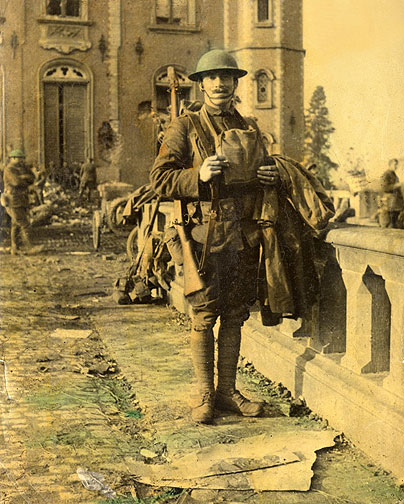
Cecil Holland, dressed for combat, in Europe in 1918
.
THE
MAN
OF 1,000 FACES
Holland returned to Hollywood by early 1920. Given
that a
three-year absence in Hollywood is like a 50 year
absence anywhere
else, it's a testament to Holland's talents that he was
back in
business almost immediately, transforming
well-known wrestler
Bull Montana into a gorilla for a melodrama, "Go and Get
It."
To help publicize that he was back in town, Cecil wrote
a series of
articles on movie make-up for "Camera" magazine, a
motion picture trade
publication, and was the solo performer in a
widely-distributed
"Camera"-produced short called "The Mind of Man."
In it,
Holland plays all five very different-looking
characters, and at the
end of the short, shows the viewer how he did it through
the magic of
make-up.
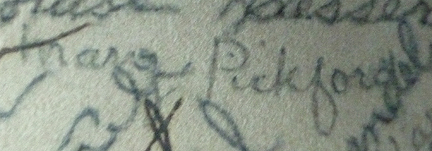
Mary Pickford
In 1921, Cecil did make-up for the Mary Pickford
films
"Little Lord Fauntleroy" and "The Love Light," as
well as a
Jackie Coogan starrer, "My Boy." At the time, Mary
Pickford
was inarguably the most famous woman in the world and
Coogan, fresh off
Charlie Chaplin's "The Kid," was the hottest child star
in
Hollywood. Holland was most definitely "A-List."
Cecil also performed in a pair of Paramount pix called
"The Great
Impersonation" and "A Wise Fool." Cecil promoted himself
as "The Man of
1000 Faces." I know. You think this was Lon
Chaney's monicker. And you're right. But not
until
Cecil gifted his pal with the title years later.

Lon Chaney
1922 brought roles in four more movies, with Holland
playing dual
characters in the best known of them, the Rudolph
Valentino vehicle
"Moran of the Lady Letty." This is the only Cecil
Holland
silent movie I was able to locate on DVD, and I can
report he was quite
a good actor, with an expressive face and considerable
"presence." And his dual make-up concoctions made
it
virtually impossible to tell it was the same actor
playing the parts -
a Mexican bandit and an old seaman who shanghais
Valentino.
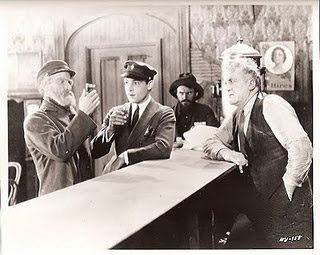
Cecil
Holland (left) and Rudolph
Valentino in yachting cap (center)
in "Moran of the Lady Letty."
Also in
1922, the 35 year old Holland eloped with Norma
Taylor, 11
years his junior. To top off the year, Cecil
signed a
two-year contract with Samuel Goldwyn Pictures as a
stock player, while
continuing freelance make-up work all over town.
The media started
paying attention to Cecil Holland. There are
headlines from
this era in the "Los Angeles Times" entertainment pages
like "Wrinkles
in
Norma [Shearer]'s Face His Doings" and "Holland to Hand
Jack [Dempsey]
Black Eye." It's clear that if the LA Times had
speed dial in
those days, Holland's name and number would have been
next to the entry
for "story on movie make-up."
WELCOME
TO
M-G-M
1925 was a watershed
year for Holland. He started off by transforming
Bull
Montana into an apeman - again - but this time for "The
Lost World,"
one of the best remembered of all silent movies.
Famous
wrestler
Bull Montana as an apeman in "The Lost World."
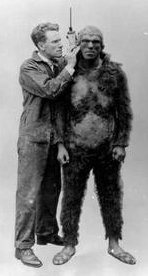
Cecil
making up Bull Montana for "The Lost World."

Bull
Montana
And
Holland
was then signed to an acting contract by one-year old
M-G-M. Simultaneously,
and
much more significantly, Cecil was hired by M-G-M
chief Louis B. Mayer to form a permanent make-up
department, the first
to exist at a major motion picture studio.
M-G-M
was a factory with films rolling off the assembly line
about once a
week. Having a make-up department that produced
consistent,
reliable, and even inspired make-up was an indispensable
part of the
mass-production process.
It is likely that one of Holland's first assignments at
M-G-M was the
gargantuan epic "Ben-Hur". Over 3,000 extras for
the
legendary
chariot race sequence were tended to by a small army of
make-up artists
using Max Factor body paint (at 600 gallons, it was
Factor's largest
order to date). And in addition to working his
magic on
famous faces and not so famous faces (M-G-M, like all
studios, was
constantly making screen tests of potential contract
players), Holland
had considerable administrative challenges - setting up
a permanent
make-up facility, hiring and training other make-up
artists, not to
mention analyzing the make-up needs of 50+ films and
shorts a year.
With those kinds of responsibilities (think of tending
to those famous
M-G-M stars - Greta Garbo, Norma Shearer, Joan Crawford,
John Gilbert,
Lillian Gish, Buster Keaton, Marion Davies, Renee
Adoree, Mae Murray,
Ramon Novarro! Norma Desmond was right; they
really did
have
faces then), it's not surprising that Cecil only had
time to appear in
small roles in two films during 1925 and 1926.
There was "The
Show," a goulash about a Hungarian carnival troupe
directed by Tod
Browning and "The Blackbird," starring Holland's good
friend Lon Chaney
(one can just imagine their conversations about
make-up).
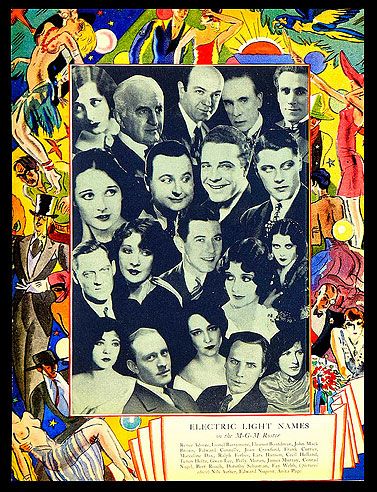
A 1927 MGM advertisement featuring
some of their stars, almost-stars
and supporting players. Cecil is in the upper
right corner.
With some naked ladies around the border, this was
probably created for
exhibitors,
not the general public.
In
1927, Holland's wife gave birth to their daughter,
Margaret, joining
a son, Richard, who'd arrived a few years earlier, and
by then they
were
residing, with a live-in servant, in a hillside house
with a pool up on
Hazen Drive in the Coldwater Canyon section of Beverly
Hills. The house had a tunnel into the mountain
which led to
a secret barroom (the influence of Prohibition on
interior
design?).
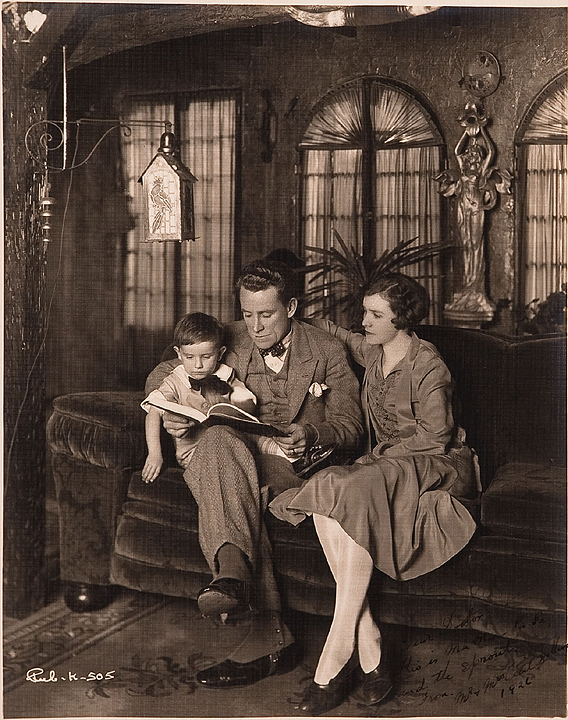
Richard, Cecil
and Norma Holland at home.
Check out those spats Cecil is wearing.
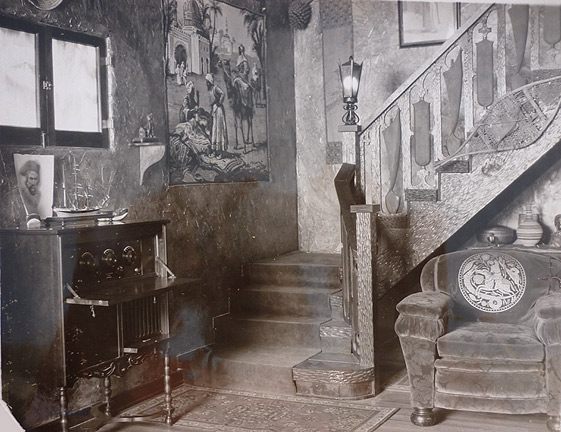 The
Holland
house was filled with mementos picked up on
Cecil's world
travels.
The
Holland
house was filled with mementos picked up on
Cecil's world
travels.
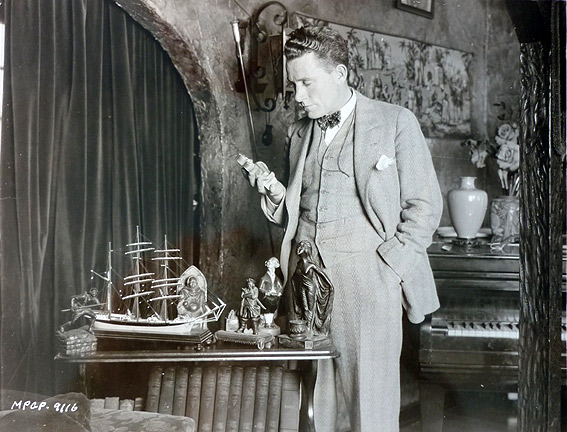
Cecil
Holland,
circa 1926, thanks to an
M-G-M publicity still.
The house is quintessential 1920's - filled
with velvet furniture, dark walls,
and
heavy curtains to keep out the California sunlight.
THE
ART
OF MAKE-UP
This
was also the year when Cecil
decided to
capitalize on his official M-G-M title - Director of
Make-Up. We
all know
"self-promotion" is the lifeblood of Los Angeles.
It must be
something in the water out here. Cecil had a plan
to open a
school for aspiring make-up artists. And to make
himself
known to those wannabes beyond the small world of
Hollywood, he wrote
the very first book on movie make-up, a slim hardcover
volume of not
much more
than 100 pages called The
Art
of Make-Up for Stage & Screen.
Cecil
Holland wrote the
first book ever written on the art of movie make-up.
The
book's first pages are devoted to lengthy
testimonials,
swearing to Holland's prodigious talents, signed by Mary
Pickford,
Douglas Fairbanks, Norma Shearer and John Gilbert, among
others. To top that, there's an erudite preface
written by
Lon Chaney that stresses Holland's quarter of a century
experience as
an
actor; Chaney assures the reader that Cecil knows his
stuff.
The fact that Cecil is the Director of Make-Up
at M-G-M is
mentioned frequently. Holland understood the
concept of
"branding" before there was a name for it.
The
book is jam-packed with the "how-to" for everything from
"straightening" a nose through make-up to the skinny on
beards,
wrinkles, harelips and looking Asian (a Holland
specialty).
By way of illustration, the book is peppered with
full-page portraits
of Holland in a dozen disguises - The Fisherman, The
Drunkard, The
Pirate, The Clown, The Witch, the Chinaman, the Sheik,
and, most
startlingly, as Jesus backlit with a heavenly halo --
many of which
were
used in his M-G-M composite picture.
All nine of the characters in this 1925 M-G-M
composite are Cecil
Holland,
the original "Man of 1,000 Faces."
Cecil Holland as You Know Who
There are
lots of little tricks revealed, one of the most
surprising being that
to
replicate the look of a blind man with milky white where
the eyeball
should be, cover the actor's eyeball with the
translucent inner skin of
an eggshell. Holland had used this trick on an
actor named
Raymond Bloomer back in "The Love Light" in 1921, and
Lon Chaney
reputedly used it in "The Road to Mandalay" in 1926.
The Art of
Make-up ends with a list of Max Factor products
every
make-up artist
should have, including Grease Paint Tubes and Liquid
Body Make-Up in
many shades including Mikado (I'm guessing this is an
artful euphemism
for
Asian). There's also a glossary of non-cosmetic
products a
make-up artist needs to keep in his "toolbox" for
transforming facial
features - mortician's Plasto wax, flexible and
non-flexible Collodion
(used for "new skin" and "scarred skin"), guttapercha
(dentist's used
this for temporary fillings), fish skin (a medical
product useful for
pulling the skin and making Caucasian eyes look
Asian). I
asked make-up artist Roy Helland (who's won an
Oscar and an
Emmy doing hair and make-up for Meryl Streep for 30
years, so he knows
a thing or two hundred about transformative make-up) if,
85 years
later, these were non-cosmetic products you could still
find today, and
he said "Yes. In a museum."
TALK.
TALK.
TALK.
I can't find any record of Cecil's School of Make-Up
opening, so
it may have been a time-management casualty of the
arrival of
Talkies. The upheaval caused by going from silent
pictures to
sound pictures wasn't just about which star had a
mellifluous voice; it
also greatly affected the technical aspects of
filmmaking, including
movie make-up. Silents were shot with noisy carbon
lights.
Adding microphones to a movie set necessitated a switch
to quiet
tungsten lights. But, the orthochromatic film that
had been
used since the early Teens wasn't sensitive enough to
clearly record
images with the new lighting. An industry-wide
change to
panchromatic film occurred. Panchromatic film
required much
more light -- "end-of-the-world-with-a-bang" kind of
light, to be
precise. And more light required a new approach to
make-up
and make-up application - different make-up, less
make-up, different
shades and much more thinly applied.
Replacing the actors who didn't make the switch to sound
were a raft of
new M-G-M stars - Clark Gable, Myrna Loy, Jean
Harlow! And,
during this transition period, Cecil made his final
appearance in a
film - a cameo, if you will - in his one and only talkie
- "Mata Hari,"
filmed in 1931. The script called for Greta Garbo
to ask a
question of a blinded WWI soldier during a hospital
visit to her lover,
Ramon Novarro. Cecil, using the old egg shell skin
trick,
played the part himself.
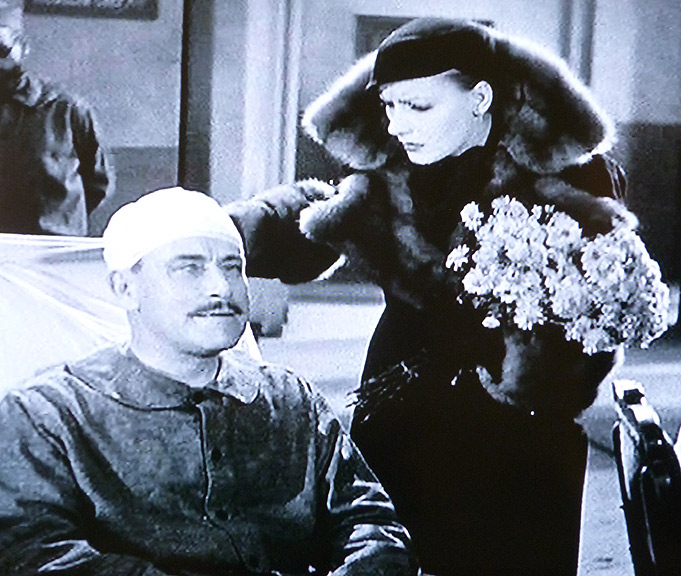
Hello,
Greta.
Goodbye, Silver Screen.
Cecil Holland's last film role is a blind soldier
who has a brief encounter with Greta Garbo in 1931's
"Mata Hari."
Holland
is very affecting in the
"Mata Hari" scene, exhibiting a serene and still
demeanor and speaking
in a tenor-ish voice with a mid-Atlantic accent.
From his
years on stage, he was very adept at accents, so there's
no way of
knowing if this was his off-screen voice, too. And
if you
have a swan song in moving pictures, there are worse
ways to do it than
playing a scene with Greta Garbo in her prime.
Around this same time, Cecil was developing extensive
make-up for Helen
Hayes in "The Sin of Madelon Claudet," the hoariest
story of mother
love ever put on the screen (it makes "Stella Dallas"
and "Madame X"
look like episodes of "Modern Family.") Hayes has
to age over
30 years in this saga of a sweet young thing who is
abandoned by her
fiancee, gives birth out of wedlock, is thrown out by
her father,
marries an older man who turns out to be a jewel thief,
is sentenced to
10 years in prison although she's committed no crime,
and then turns to
prostitution and petty thievery to not only survive but
pay for her
estranged son's medical school studies. Are you
seeing all of
the amazing make-up opportunities here? Holland
did, and gave
Hayes a half dozen realistic looks as she inexorably
slid down the
rungs of the social ladder. Of course the film was
a huge hit
and won Hayes the Best Actress Oscar for 1931-32.
Cecil
helped her win that Academy Award in the same way the
creator of the
Virginia Woolf nose helped Nicole Kidman win her Oscar
for "The Hours."
A week or so after the film's premiere, Hayes wrote
Holland:
Dear
Cecil
Holland
Our
nightmare
of last summer has turned out to be a triumphant
picture here
in New York. I have received great praise for
my masterful
makeup. It makes me feel guilty, so I hereby
forward that
praise to you, where it belongs. I'm ever so
grateful for
your patience and artistry.
God
bless
and good luck.
Helen
Hayes
 Helen
Hayes
Helen
Hayes
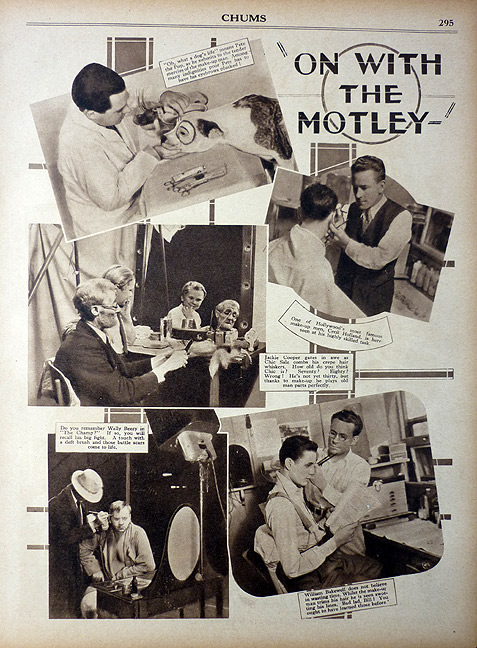
A feature on Hollywood make-up appeared in
"Chums," a British magazine
for boys,
in 1932 with two pictures on the right of Holland at
work.
Pictures by such eminent M-G-M staff photographers as
Clarence Bull had
been taken of Cecil at work as early as his first year
at the
studio. There are photos memorializing him
finishing out an
eyebrow for Joan Crawford in 1928's "Our Dancing
Daughters" (the silent
film that rocketed her to stardom); of drawing the
circle around the
eye of Pete the dog from the Our Gang comedies; of
examining his
creation of the grenade-caused scars on the right side
of Lewis Stone's
face in "Grand Hotel"; and of making Boris Karloff look
sinister and Asian for the 1932 "The Mask of Fu Manchu."
(Karloff lived
next door to Holland, and his co-star, Myrna Loy,
moved in just around the corner several years later --
Who says
Hollywood isn't a small town?) In all of the
photographs, Cecil expertly plays the part of the
focused and serious
make-up artist, allowing the "star" to be the true
center of attention.
Cecil Holland working his magic on the eyes of
Joan Crawford
for 1928's "Our Dancing Daughters."
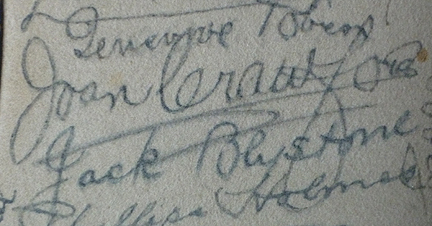 Joan Crawford
Joan Crawford
Drawing the circle around the eye of Pete the dog
for the "Our Gang"
films.
Applying final touches to the war wounds on the
face of Lewis Stone for
"Grand Hotel,"
under the watchful eye of director Edmund Goulding.
Lewis
Stone,
remembered best for playing Judge Hardy in the Andy
Hardy series
of films, also uttered one of the best-remembered
closing lines in a
movie:
"Grand Hotel. People come. People go.
Nothing ever happens."
Stone was a contract player at M-G-M from its
inception in 1924 until
his death in 1953 -- the longest-known uninterrupted
association of an
actor and a
studio.

Lewis
Stone
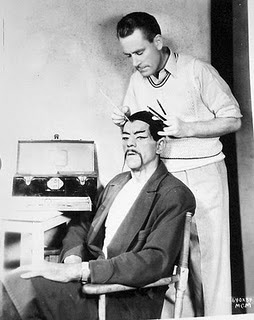
Turning
Boris
Karloff Asian (and sinister) for "The Mask of Fu
Manchu."
Boris
Karloff
Also
from 1932 is a
picture of Holland using a magnifying loupe to check
out the
just-finished maquillage of Jean Harlow at her most
"platinum," while
she sits in a barber's chair dressed in a polka dot
wrapper and
Spring-o-later-style pumps. I love this
picture.
It's set in what is clearly Cecil's "office." On
the wall is
a picture of him with wife Norma and their son, a copy
of Holland's
1925 composite pic and a bevy of framed portraits of
him in character
make-up. Center stage is the
photograph of Holland as Jesus, which is flanked by
smaller pictures of
Cecil's parents (I wouldn't touch the symbolism of
that with a 10 foot
long tube of lipstick). But, all of the
reminders of
his former career don't seem like a desperate
attempt at hanging on to the glory days. They
were visual
substitutes for Holland saying to those who sat in his
make-up
chair: "Hey. Relax. I'm just like
you. I understand what it's like to be an
actor.
So, sit back and don't worry; I'll make you look
your
best."
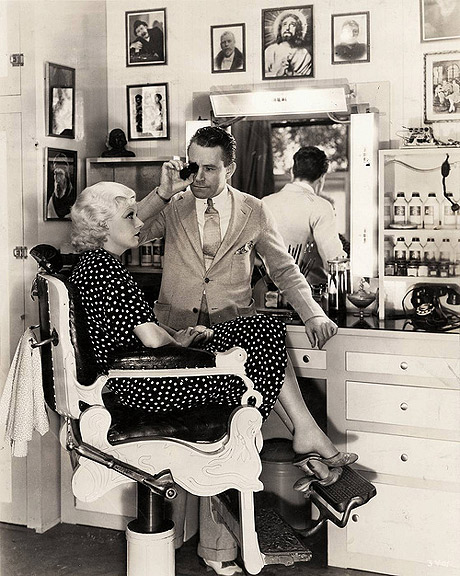
Jean Harlow under the Master's gaze.
SHAW
GOES
HOLLYWOOD
As
mentioned earlier,
one of the most stunning discoveries while deciphering
the names on the
hat was that of George Bernard Shaw. In 1933,
world-renowned
playwright and Nobel laureate Shaw visited the United
States for the
only time in his life. Accompanied by his wife,
Charlotte,
Shaw was on a year long cruise around the world and got
off his ship,
The Empress of Britain, in San Francisco and went down
the coast to
spend a night at William Randolph Hearst's fabled
estate, San
Simeon. On the morning of March 28, Hearst
instructed his pilot to fly the Shaws down to the Santa
Monica airport
in Hearst's private plane. The pilot was bedeviled
by thick,
low coastal fog, and knowing that he'd never find the
airport, made an
emergency landing on the sands of Malibu beach.
Unperturbed,
the Shaws hitchhiked a ride from a passing UCLA student
who dropped
them off at the airport, where they were met by Louis B.
Mayer and a
phalanx of his underlings.
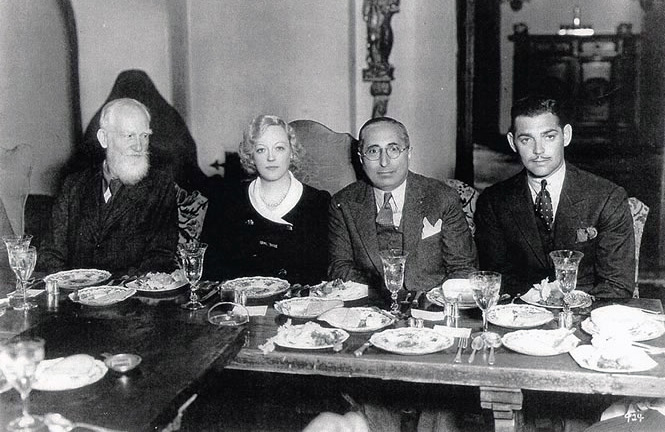
George Bernard Shaw with Marion Davies, Louis B.
Mayer and Clark Gable.
Why is nobody having a good time at this lunch?
Once at M-G-M in
nearby Culver City, the Shaws were given an exuberant
tour of the lot
by Cecil Holland. Louis B. Mayer chose Holland
because, like
Shaw, he was a Brit, and he assumed the regional
connection would make
for a smooth hour. The hour must have been just
fine, because
Shaw did sign "the Hollywood Hat." But the rest of
the three
hour visit seems to have gone south. Shaw insulted
many of
those he encountered -- reporters, actors and, judging
by the dour
expressions in the picture above, most, if not all, of
his companions at lunch. The luncheon was hosted by
Marion Davies in her 16 room
"bungalow" dressing room. The guest list included Mayer,
Charlie Chaplin,
Clark Gable and John Barrymore, to whom Shaw refused an
autograph. Shaw was definitely Mr. Nastypants that
day before
heading back to his ship. For the next week, the
Los Angeles
newspapers' chatter and gossip columns were filled with
civic umbrage
and the provincial equivalent of "who does he think he
is?"
Shaw certainly knew how to make an impression.

Marion Davies
|

John Barrymore
|
CHANGE
PARTNERS
After a decade at M-G-M, Holland was ready for a
change. He
was almost 50 (do I hear the phrase "mid-life crisis" in
the house?)
and almost certainly tired of all of the administrative
duties that
came with being the head of the Make-Up
Department. Cecil
loved doing make-up and teaching make-up, not filling
out forms about
make-up. M-G-M's success was also Holland's
success. He stood at the absolute pinnacle of his
profession,
and decided to cash in while giving himself new
challenges.
Cecil did what almost no one in the film business did in
1935; he gave
up a sure-thing contract in the middle of The Great
Depression and went
on to free-lance with a series of short-term, and no
doubt lucrative
assignments.
In 1935, Holland first went to newly-formed 20th Century
Fox, the
hottest
studio in town, and unpacked his make-up box.
Among the stars
he worked on was Shirley Temple, then the biggest draw
in the
movies. And, while there, he got lots more
signatures on "The
Hollywood Hat" from folks who sat in his chair - among
them, Alice
Faye, Will
Rogers, Sonja Henie, and Cesar Romero.
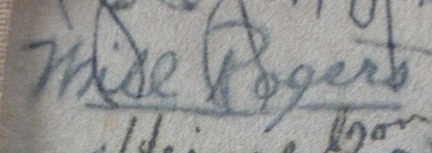
Will Rogers
|

Alice Faye
|
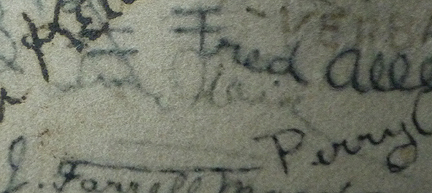 Sonja
Henie
Sonja
Henie
This appears to be where the hat was finally "filled
up." You
can
tell because many of the signatures he only could have
gotten at 20th
are small and appear in those leftover areas of the hat
between big
signatures. The penultimate addition to the hat --
at least
four
years later -- is actor George
Montgomery, who signed the hat twice, including once
where the hatband
used to be. Born George Montgomery Letz, he didn't
go by
"George Montgomery" until 1940, when he was put under
contract by Fox.
Both Montgomery and Holland shared painting and
sculpting as
hobbies, and I suspect they bonded over these mutual
interests, enough
for Holland to pull the hat out of the closet and have
George sign it.

George Montgomery
When M-G-M started "The Good Earth" in 1936, Jack Dawn,
now the head of
M-G-M's Make-Up Department, hired back Cecil for his
expertise to
transform decidedly Caucasian Luise Rainer into Asian
O-lan, the female
lead character. Dawn worked on the male lead, Paul
Muni.
Why not cast Asians and save a lot of
trouble?
Well, with a $2 million dollar budget (six or seven
times the typical
M-G-M budget at this time), the film's producer, Irving
Thalberg,
insisted on box office names. And there simply
were no Asian
box office names in 1936.
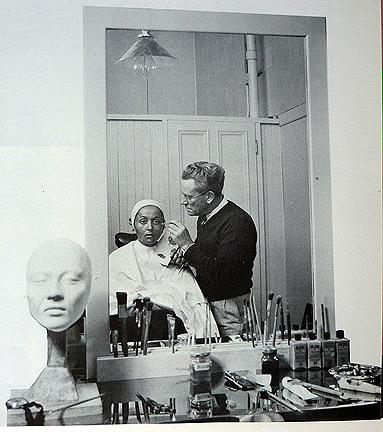
Transforming Luise Rainer into the Chinese farmer's
wife, O-lan,
for
"The Good Earth" in 1936.
Production took up
much of 1936, and Holland and Rainer had one colossal
disagreement. Luise wanted her fingernails
manicured. Cecil not only wanted them unpolished,
he wanted
to put dirt underneath the nails. After all, she
was a
farmer's wife, not a shopgirl in a Peking
emporium. Cecil won
this battle in the name of authenticity, and Rainer won
her second
consecutive Oscar for Best Actress.
In March, 1937, Holland interrupted his free-lancing and
agreed to head
up the Make-Up Department at the Hal Roach Studios. It
was at this
exact point in time that Roach switched the studio's
emphasis from
comedy shorts to A-List features, such as "Topper" with
Cary Grant and
Constance Bennett. It was also in 1937 that a
decade-long
quest of Holland's finally ended. In the late
1920's,
Holland, along with other noted make-up artists and hair
stylists,
formed the "Hollywood Motion Picture Make-Up Artists
Association" as a
first attempt to unionize their profession and affiliate
with organized
labor. It took them five years to find a home, and
it was
first with the painters' union; the logic being that
both groups'
workers used brushes. Finally, in 1937, IATSE,
which
controlled most of the unions in Hollywood, relented and
gave a charter
to the make-up artists and hair stylists; Local 706 was
born.
Cecil didn't stay at Roach very long; in the summer of
1938, he was
called again by Dawn at M-G-M with a irresistible offer
to work on the
much anticipated "The Wizard of Oz" (talk about
character make-up) and
he finished out the 1930's on the Yellow
Brick Road. "The Wizard of Oz" was such a huge make-up
and hair
operation that the prep area filled an entire
soundstage.

Frank Morgan
|

Billie Burke
|
The 1940's was a period of active free-lancing for
Holland with stints
at 20th and Warner Brothers, among others. For
most of the
decade, there
are no credits for Holland that I can find (and Local
706 no longer has
work records from this period). The practice
during the 40's
was to give the head of the Make-Up Department the
screen credit, if
the credit was mentioned at all. An individual who
worked in
the Department, whether under contract or as a
free-lancer, was
invisible. Holland started a sideline business
doing oil
portraits, and one of his commissions was painting the
pet of Betty
Grable and bandleader Harry James. I'm not sure if
this
happened because of knowing Grable at 20th or from Betty
and Harry
being Cecil's nearby neighbors.
Cecil appears to have finished out his career mostly
working at Republic
Pictures. Holland got screen credit for the
make-up on 1949's
"The Fighting Kentuckian" starring John Wayne, and then
"Borderline" in
1950, a "tense" drama with Fred MacMurray and Claire
Trevor.
1951 saw Cecil's last notable (though uncredited)
achievement in movie
make-up. This came about via Lee Greenway, one of
his former
interns when both were at 20th in the 1930s.
Greenway is most
famous for creating the alien monster make-up worn by
James Arness in
"The Thing From Another World," produced by Howard Hawks
at R-K-O.
Greenway didn't have the hours each day to apply
Arness'
make-up, so he hired "Teach" for the task.
Undoubtedly,
Holland and Arness became close during the weeks of
filming.
James Arness was the last person to sign "The
Hollywood Hat."
 James
Arness
James
Arness
Having
reached what may have been mandatory retirement age in
1953, Holland
left
make-up work for good and turned his attention to his
other artistic
pursuits.
In 1965, at the age of 78, Cecil suffered a paralytic
stroke.
After extensive therapy, he still had trouble with
speech.
Apparently, when the
ability to express the right words failed him, Cecil
reverted back 50
years, and, as in his silent movies, he would act out
what he wanted to
say. In 1973, he was beset by another stroke,
complicated by
pneumonia. This proved to be too much for him, and
Cecil
Holland died in Sherman Oaks on June 29, just one month
after his 86th
birthday.
Cecil left a 40 year legacy of dozens of films in which
he acted and
hundreds of films for which he created the
make-up. More
importantly, for four decades, he had generously and
eagerly shared his
vast knowledge with other make-up artists, training
countless
individuals in the complex and fine art of creating
make-up illusions
and beauty (come to think of it, sometimes beauty IS a
make-up
illusion.)
And Cecil left behind "The Hollywood Hat."
A
WINDOW INTO HOLLYWOOD
For me, the hat is a series of windows
into Hollywood and all those who
signed it when the movies first talked. But it was
much more
than that for Holland. His daughter, Meg, says it
was his
"pride and joy." That's a good start. By the
time
Cecil got to M-G-M, he'd been to the fair and he'd been
around the
block (hell, he'd been around Cape Horn in stormy
seas). It's
a certainty that he recognized that being the Director
of Make-Up at
the biggest, richest, most glamourous and successful
studio in
Hollywood was "It." These were the best years of
his
professional life, and he loved most every minute of
it. What
better way to memorialize the daily joy than to get
autographs of
everyone meaningful to sit in his make-up chair, and to
have all the
signatures in one place - on the hat? It's not
that different
than a high school yearbook where your best friends pick
up a pen and
leave a little piece of themselves for you to remember
them by.
Studios are just like small towns -- with couples who
are married, like
Charles Boyer and actress Pat Paterson ...
Charles Boyer and wife Pat Paterson
on board the
French luxury liner Normandie in the
late 1930's. After 44 years of marriage,
Pat died.
Boyer, unable to face life without her,
committed suicide two days later.

Charles Boyer
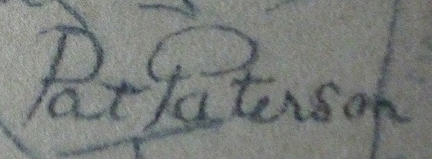
Pat Paterson
George Burns and Gracie Allen ...
When George Burns and Gracie Allen started
their
vaudeville act in the early 1920's,
George played the illogical character and Gracie
was the "straight
man." Her signature
may have faded on the hat, but thank goodness
the memory of her
whimsical comedy hasn't.

George Burns

Gracie Allen
and couples the public thought should
be married, like William Powell
and Myrna Loy ...
William Powell and Myrna Loy made a whopping 14
movies together.
During the time they made these movies, they
were married to others a
total of 5 times,
but never to each other. Asta, played by a
wire-haired fox
terrier named Skippy,
was their co-star in the popular "The Thin Man"
series. Alas,
Skippy didn't make
a paw print on the hat.

William Powell
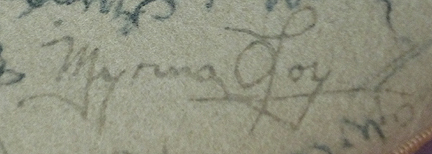
Myrna Loy
and Jeanette MacDonald and Nelson Eddy.
If Nelson Eddy had his way, he and
Jeanette
MacDonald would have been married in real life.
During much of the time they were teamed on 8
musicals, the two had an
on-again,
off-again romance, with Eddy pressuring
MacDonald to marry him and give
up her career.

Jeanette MacDonald
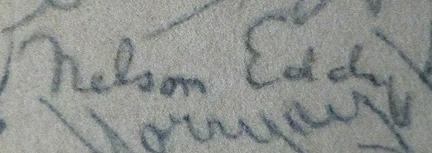
Nelson Eddy
CECIL
AND
"THE KING"
There are two great publicity
photographs M-G-M took of Holland in 1932. One is
of Cecil
and Clark
Gable on the staircase in the back of the dressing room
building.
Gable has the hat with his hand holding a pen at
precisely the place on
the hat where he signed it. M-G-M's caption says
there are
over 2,000
signatures on the hat which is typical Hollywood
hyperbole; there were
probably no more than 250 at the time. Gable is
looking at
Holland,
but Holland is looking at the hat.
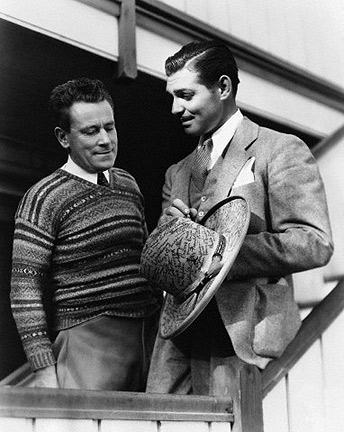 Clark
Gable
autographing
the
hat.
Clark
Gable
autographing
the
hat.
Provenance doesn't get any better than this.

Clark Gable
The
other photograph is of Cecil
alone, wearing the hat, with a vast expanse of the
underbrim still to
be filled in. The camera catches him with a
Cheshire cat
smile. He
is clearly proud to be wearing this hat. (And, on
an
interesting
sartorial note, he's wearing a collar pin, a tie tac and
a tiebar.)
Cecil Holland sporting his "pride
& joy," October 1932.
Once "complete," the
hat was stored in Cecil's foyer
closet on Hazen Drive. His family says that
Holland would
often take it out of the closet and show it off to
company.
Although it wasn't yet a dazzling historical pop culture
artifact, I'm
sure it sparkled plenty when the names were still
current.
By the way, Holland wasn't the only make-up artist to
have an unusual
way of collecting autographs. Clay Campbell, who
spent 33
years as a make-up artist, most of those years heading
Columbia
Pictures' Make-Up Department, had over two thousand of
the actresses he
beautified put their fresh lip imprints on pieces of
paper and then
sign them.
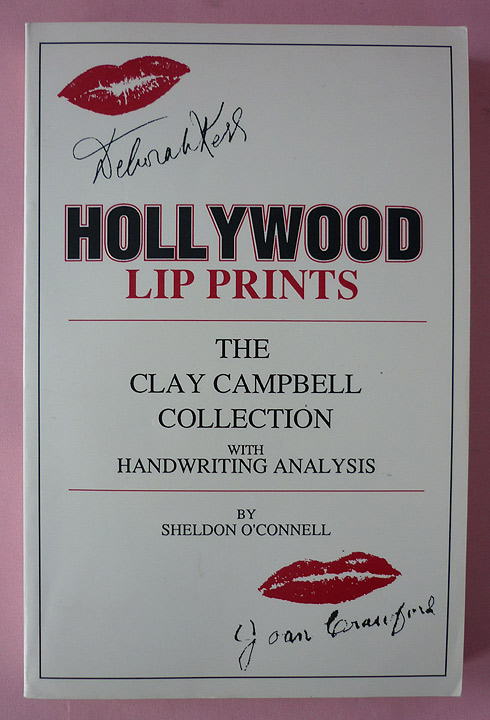
Hollywood Lip
Prints
Sheldon O'Connell's book about Clay Campbell's collection
of 2,000 lip
prints
George Westmore, the patriarch of multi-generations of
make-up artists
(his sons, at one time or another, ran practically every
major studio
make-up department) also collected about 100 autographs
in a small
leather-bound album. It was available in the
December, 2011
Debbie Reynolds auction, and, even in terrible condition
- water
damage, loose pages, etc. - it sold for more than
$3,000. An
interesting piece of trivia is that when M-G-M sent
Cecil Holland to
England on studio business for a few months in 1929,
George Westmore
was his temporary replacement as the Director of Make-Up
at M-G-M.
And the hat wasn't Cecil's only experience with
autographs.
During World War I, he'd been contacted by a British
women's service
organization, requesting signed movie star pictures to
cheer up wounded
veterans. He assembled over 100 of them and
shipped them off
to England. And, a few years ago, a hardbound copy
of "The
Wizard of Oz" came up for auction in England. It
had been
signed by all the principal cast members of the 1939
movie, and the
auction catalog noted that the book had been a gift to
the consigner's
great-grandfather, a friend of Cecil Holland, who had
the book signed
during production of the film. The book sold for
the
equivalent of $10,000.
Cecil had the cast sign this copy of "The
Wizard
of Oz" as a
gift for a friend,
which, 70 years later, sold at auction for $10,000.
THE
DEMOGRAPHICS
OF THE HAT
The "demographics" of the hat tell us a lot about
Holland,
too. 80% of the signers are men and only 20% of
the signers
are woman. It's not that Cecil couldn't do beauty
and glamour
(Gloria Swanson, Jeanette MacDonald, Joan Crawford - and
they weren't
playing stay-at-home Moms in housecoats and curlers),
but he
found working
on actors more rewarding. Walter Huston once
inscribed a
photo to Cecil which called him "God's gift to character
actors." Such were Holland's talents at painting
character on
a face that I think that's where he spent most of his
time.
The hat is filled with the names of dozens and dozens of
character
actors. The names might not be familiar, but the
moment you
see their picture, the response is "Oh, that guy.
I've seen
him in a hundred movies."
It's also interesting
to realize who, among the M-G-M stars Cecil worked on,
didn't sign the
hat. For one, there's Greta Garbo, which isn't a
shock. Garbo famously signed almost nothing but
checks and
contracts. In the 1995 book "Garbo" by Barry
Paris, he
relates Greta's response to the thousands of fan letters
that arrived
every week at M-G-M, and which were burned,
unread:
"Who are all these people who write? I don't know
them. They don't know me. What have we to
write
each other about? Why do they want my
picture? I'm
not their relative." A hilarious response.
And
astute. And very practical.
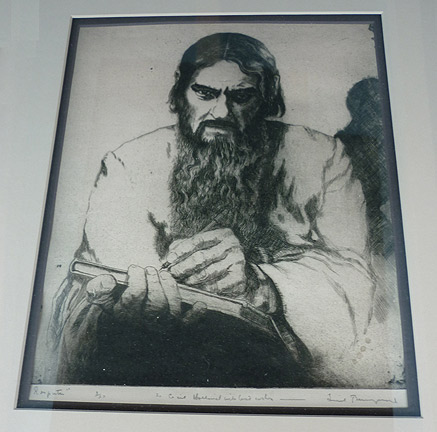
Lionel
Barrymore as Rasputin in "Rasputin and the Empress."
Make-up by Cecil Holland. Barrymore did the
etching himself
and gave it to Holland at the end of the shoot. For
whatever reason,
Lionel Barrymore never signed the hat.
Eight years is a long
time to collect autographs and Cecil mistakenly had some
sign the hat
twice, including character actors Walter Huston, Lee
Tracy, Conrad
Nagel, C. Aubrey Smith, and Roland Young, as well
as the
platinum bombshell herself, Jean Harlow. The
Harlow
signatures may be the rarest on the hat. She was
very shy
around her fans and rarely signed in-person
autographs. And
it is well-known in the autograph community that
virtually all of the
signed photographs of Harlow now floating around were
actually signed
by her mother, Mama Jean.

Walter Huston 1
|

Walter Huston 2
|

C. Aubrey Smith 1
|

C. Aubrey Smith 2
|

Jean Harlow 1
|

Jean Harlow 2
|
THE
DEMOGRAPHICS
OF FAME
The "demographics" of fame
as represented by the names who signed the
hat are fascinating. "Lasting fame" is measured in
different
ways in Hollywood. Foremost is earning an Oscar
nomination
or, better yet, the statuette itself. Every Oscar
winner
knows that the lead sentence in his or her obituary will
read something
like this:
"Tonight, Oscar winner ________________ died in
___________________ (choose one: Cedars
Sinai Hospital/St. John's Hospital/at home) after a
___________________(choose one: long battle/short
battle) with
_________________ (choose one: cancer/substance
abuse/Jeffrey
Katzenberg)."
The Academy Award is simply the universal emblem of
achievement in the
film business. Nothing else comes close.
Among the signers of the hat, there are 60 individuals
who were
nominated for an Oscar 134 times. And there are 31
winners of
Oscars
(reaping a total of 41 Academy Awards), including the
cranky George
Bernard Shaw (screenplay for "Pygmalion," 1938).
Shaw
publicly pooh-poohed the award, but kept his Oscar
prominently
displayed on his mantel for the remainder of his life.
Even more exclusive than the Oscars is the forecourt of
Grauman's
Chinese Theatre, filled with the hand and foot prints of
Hollywood
immortals. A couple of thousand Oscars have been
handed out,
but there are only about 250 stars represented at
Grauman's.
(I'd give
you an exact number, but do you count or not count R2D2,
C3PO and Roy
Rogers' horse Trigger?) There are a variety of
stories of
how the footprints ceremonies began, but most agree
Norma Talmadge was
the first to get cement on her hands and shoes in
1927. Since then, there have only been an average
of three
stars added each year. Like I said, exclusive.
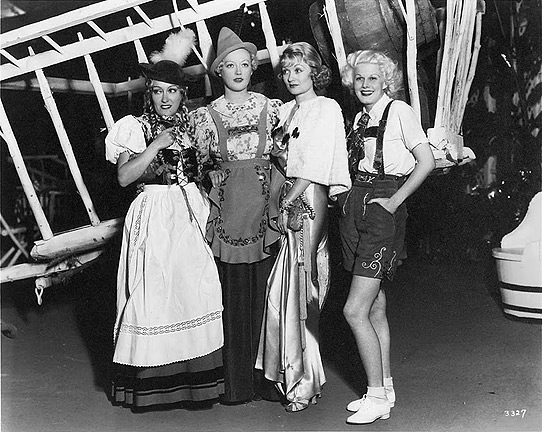 Four
lady
hat signers at one of Marion Davies' many costume
parties:
Gloria
Swanson, Marion Davies, Constance Bennett and Jean
Harlow.
The
three dressed in "Heidi" gear also have their foot and
hand prints
Four
lady
hat signers at one of Marion Davies' many costume
parties:
Gloria
Swanson, Marion Davies, Constance Bennett and Jean
Harlow.
The
three dressed in "Heidi" gear also have their foot and
hand prints
at Grauman's Chinese Theatre.

Gloria Swanson
|

Constance Bennett
|
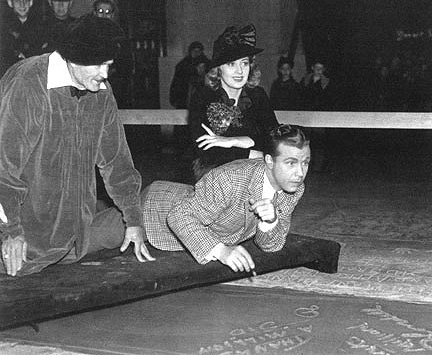 Married
couple Dick
Powell and Joan Blondell jointly leave their hand and
foot prints at
Grauman's
Married
couple Dick
Powell and Joan Blondell jointly leave their hand and
foot prints at
Grauman's
Chinese theater in February, 1937. The man
assisting them is
Jean Klossner, who created the
extra-durable concrete used in the forecourt and who
supervised the
footprint ceremonies
from 1927-1957. He was known as "Mr. Footprints."
 Dick Powell
Dick Powell
Joan
Blondell
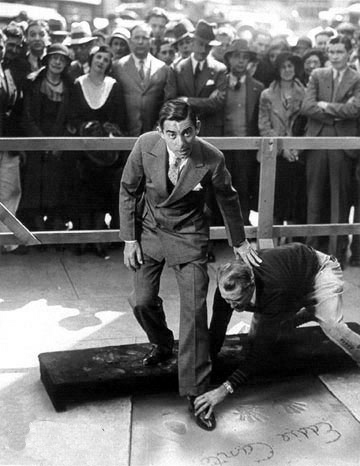 Eddie
Cantor was an enormously popular film star in the early
1930's and is
shown here,
Eddie
Cantor was an enormously popular film star in the early
1930's and is
shown here,
putting his Best Foot Forward at Grauman's in 1932.
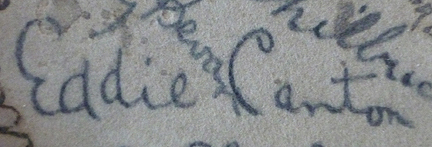 Eddie Cantor
Eddie Cantor
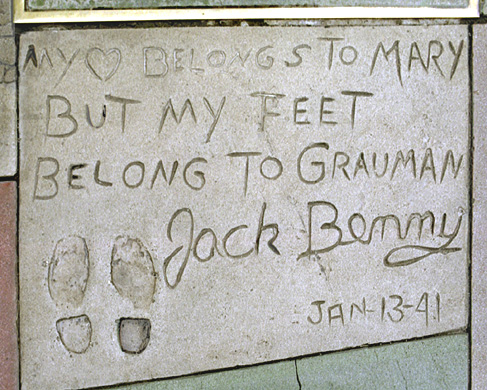 Jack
Benny's cement block at Grauman's Chinese Theater.
Jack
Benny's cement block at Grauman's Chinese Theater.
He wrote so much verbiage there was no room for hand
prints.
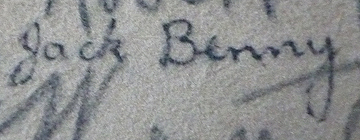 Jack Benny
Jack Benny
Of
those 250 stars, how many of them
autographed "The Hollywood Hat"?
A whopping
39. Or almost one out of every six.
Starting in
1932, Quigley Publications, a reputable motion
picture
trade publisher, annually polls theater owners for a
list of which ten
stars' movies brought in the most customers.
It's not the
most scientific way to judge box office success, but
the list is always
generally credible and it's endured for over 80
years.
Inclusion
on the list is also often mentioned in a star's
obituary.
From 1932
to 1939, thirty-three stars appeared on the Top Ten
Box Office Stars
list (clearly lots of repeats from year to
year). Of those, twenty-one autographed "The
Hollywood Hat."
That's more
than 60%.
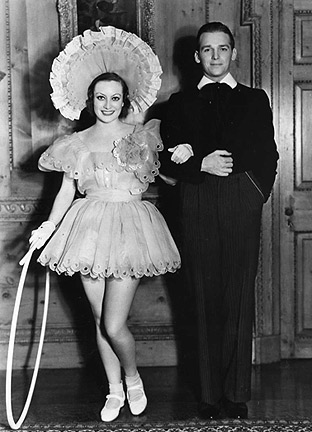
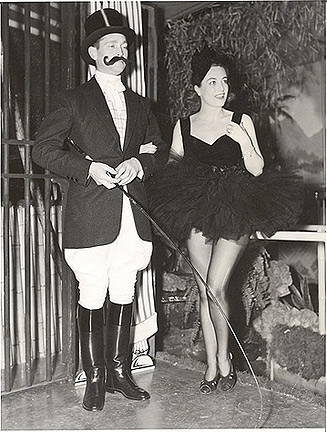
Joan
Crawford was
a mainstay of the Top Ten Box Office Stars List in its
first years.
An amazing number
of hat signers
appeared in Crawford movies, including her first two
husbands,
shown here with Joan in
Fancy Dress Ball
costumes.
On the left, husband #1, Douglas Fairbanks, Jr.
On the right, husband #2,
Franchot Tone.
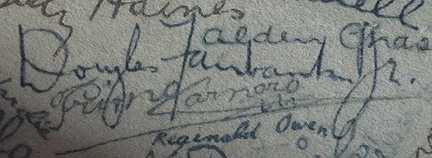
Douglas Fairbanks, Jr.

Franchot Tone
WATCH
WHERE
YOU STEP
Then there's the Hollywood Walk of
Fame, represented by all those
glittery pink stars lining Hollywood
Boulevard. When
Hollywood (the neighborhood) started to decline in
the early 1950's,
E. M. Stuart, a civic booster, came up with the idea
of installing the
sidewalk stars as a way to goose tourism. Four
committees
were formed to create lists of those worthy of a
star in any of four
areas - films, television, radio and records/music.
People
could be awarded more than one star if they had
excelled in more than one medium.
Ultimately,
1550 stars were initially awarded. The list
was
not without controversy. Charlie Chaplin's son
unsuccessfully
sued the Hollywood Chamber of Commerce for $400,000
for the omission of
his father's name. Apparently, to some, in the
tail end of
the McCarthy era, Chaplin's leftish worldview was
more meaningful than
the fact that Charlie Chaplin, the actor, had done
more to popularize
movies than anyone else in history (ps: he finally
got a star in 1972).

Charlie Chaplin
By
1961, the original stars had been
installed, and starting in 1968,
other stars were added to the Walk. About two
dozen, more or
less, have been added each year, until the total is
now close to 2500
stars. In 1984, a 5th category was added -
Theatre/Live
Appearances. It's also evolved into an honor
with a price
tag; the chosen star (or an entity acting on the
star's behalf) needs
to fork up some serious dough (currently about
$30,000) to underwrite
the cost of the installation, ceremony and future
maintenance. It's not unlike buying a plot in
a
cemetery. Both offer eternal remembrance, if
not salvation.
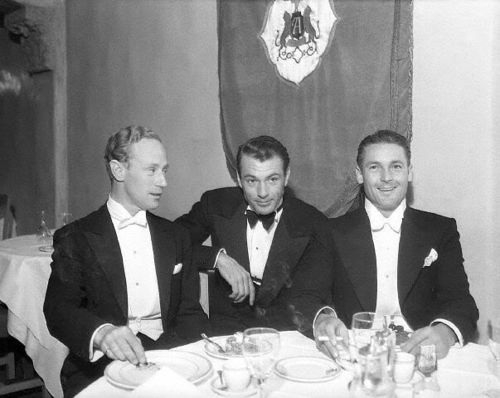 BOYS'
NIGHT
OUT
BOYS'
NIGHT
OUT
These
three very different leading men --
Leslie Howard, Gary Cooper, and Charles Farrell
--
all have sidewalk stars.

Leslie Howard

Gary Cooper

Charles Farrell
So
how did the hat signers do with the
Hollywood Walk of
Fame? 154 of them
(that's about 40% of those who signed
the hat)
are represented on the Hollywood Walk
of
Fame with 198 stars. That's a lot of sidewalk
sparkle.
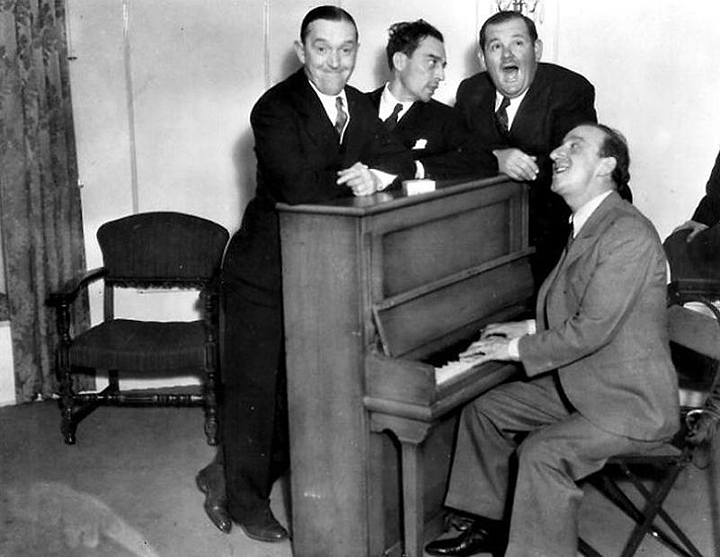
Comedy
Stars -- and Sidewalk Stars --
Stan Laurel, Buster Keaton, Oliver Hardy and
Jimmy Durante
all at M-G-M in the early 1930's.

Stan Laurel

Oliver Hardy

Buster Keaton

Jimmy Durante
It
might be tempting to put the Golden
Globes on this list as a
measurement of lasting fame, but the Globes only
started in 1943, a
decade after the era of "The Hollywood Hat."
But, there was
something in the 20's and 30's as artificial and
manufactured as the
Golden Globes. It was called WAMPAS Baby
Stars.
WAMPAS
stands for Western Association of Motion Picture
Advertisers, a
trade group of film publicists and
advertisers. Starting in
1922, the group would annually identify 13 young
actresses who were on
the cusp of stardom. They didn't call them
starlets then;
they nicknamed them "Baby Stars." Given that
publicists
created this thing, there was a huge amount of media
attention given to
the announcements - newspaper articles, newsreel
footage, personal
appearances - and being a WAMPAS Baby Star turned
out to be a big deal
at that time.
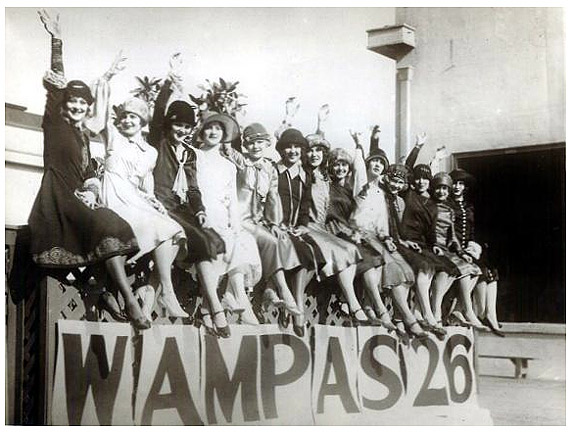
The
WAMPAS Baby
Stars of 1926.
From left to right: Dolores Costello,
Vera Reynolds,
Mary
Astor,
Marceline Day, Edna Marion, Mary Bryan,
Fay Wray, Janet Gaynor, Sally
Long, Joyce Compton, Dolores Del Rio,
Sally O'Neil, and last, but certainly not least,
Joan Crawford.
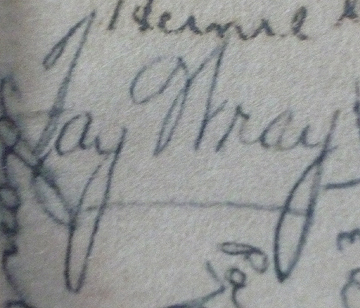 Fay Wray
Fay Wray
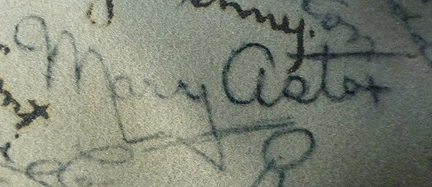 Mary Astor
Mary Astor
The
WAMPAS
group had a
pretty good track record of predicting stardom.
Among their
picks were Clara Bow, Bessie Love, Colleen Moore,
Dolores Del Rio, Jean
Arthur, Loretta Young and Ginger Rogers. Twelve
of the ladies
who autographed "The Hollywood Hat" were WAMPAS Baby
Stars including 5
from 1926 alone - Mary Astor, Marceline Day, Janet
Gaynor, Fay Wray and
the biggest Baby Star of all, Joan Crawford. The
awards ended
after the 1934 announcements due to studio pressure;
the moguls didn't
want anybody else telling them who should be a
star. The
crust of those publicists.
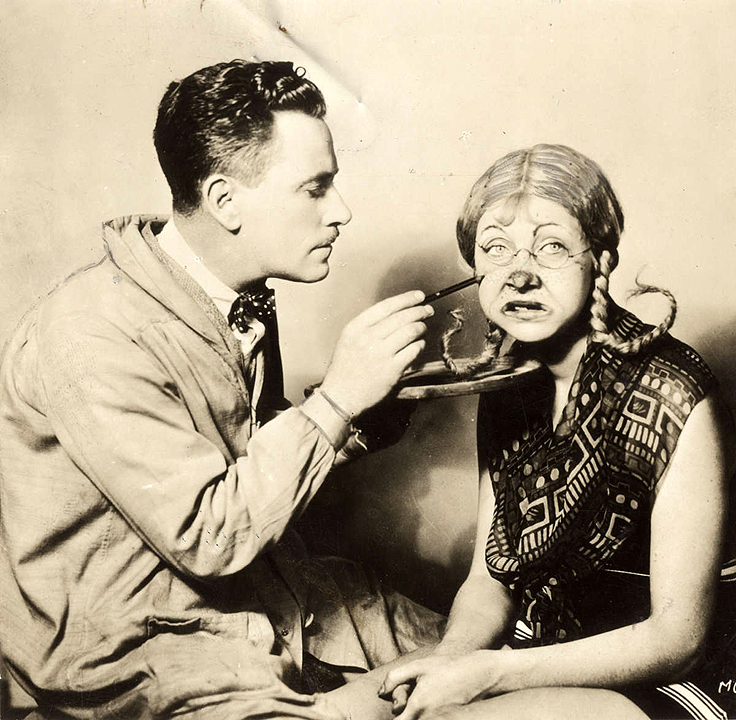 Cecil
turns glamour girl and 1928 WAMPAS Baby Star Gwen Lee
into
Cecil
turns glamour girl and 1928 WAMPAS Baby Star Gwen Lee
into
a Halloween
version of Pippi Longstocking.
It's always the silly season in Hollywood --
even for WAMPAS Baby Stars like Joan Marsh,
shown here adorned with necklaces, a bracelet,
and a ring hand-painted
onto her skin by Cecil.
A
fascinating aspect
of the hat is how it conjures up the pop culture
zeitgeist of the
time. It wasn't just actors who signed the
hat.
M-G-M and other studios were constantly doing "stunt
casting" - taking
someone in the public eye and putting them in the
movies. A
great example is 1933's "The Prizefighter and the
Lady." For
their appearances in this film, four future, present
and past World
Heavyweight Boxing Champions - Max Baer, Primo
Carnera, Jack Dempsey
and Jess Willard - sat in Cecil's chair and signed the
hat for him.
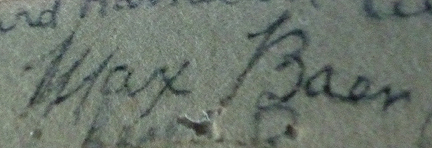 Max Baer
Max Baer
 Primo Carnera
Primo Carnera
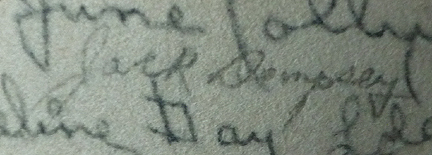 Jack Dempsey
Jack Dempsey
 Jess Willard
Jess Willard
Max Baer is the Prizefighter. Myrna Loy
is the Lady.
Max Baer, Jack Dempsey and Primo Carnera in
the ring in "The Prizefighter and the Lady."
The film, a romantic
drama, stars Myrna Loy opposite Max Baer as a boxer
who fights Primo
Carnera (playing himself) in a quest to be the next
World's Heavyweight
Champion. This clairvoyant casting mirrored
Baer's and
Carnera's professional status in the world of
boxing. Shortly
after this movie was made, Baer actually defeated
reigning champion
Primo Carnera for the Heavyweight title.
Myrna Loy once
remarked that Baer carefully studied Carnera's
boxing technique during
filming and used what he learned to best Carnera.
The
fifth boxing champ
to autograph Cecil's Stetson was James J. Corbett,
popularly known as
Gentleman Jim and known to be the "father of modern
boxing."
Corbett won his title in 1892, knocking out famed
boxer John L.
Sullivan. Errol Flynn starred as Corbett in
the 1942 Warner
Brothers biopic - "Gentleman Jim."
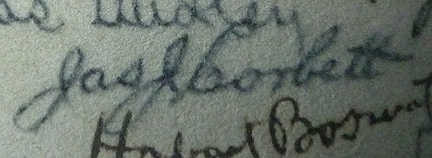 James Corbett
James Corbett
Gentleman Jim
Corbett in 1897.
Cecil
also got the autographs of those
famous folks of the time who must have just been
passing thru the M-G-M
Make-Up Department. "Red" Grange, the most
celebrated college
football player of perhaps all time, signed.
Red
Grange
Artist
Charles Dana Gibson,
the creator of "The Gibson Girl" and for whom
the Gibson Martini may
well have been named, signed too.
 Charles
Dana Gibson
Charles
Dana Gibson
As did Rex Beach, an adventure novelist once as
famous as Clive Cussler
or Robert Ludlum.
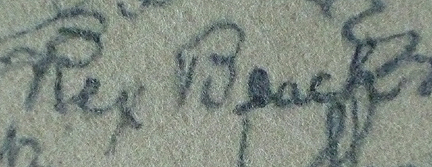
Rex Beach
As
well as Roscoe Turner, a pilot and champion air
racer who wound up
on the cover of Time
in 1934. What an appropriately aerodynamic
signature.

Roscoe Turner
Did you
guess or do you give up?
They were
all nominated for a Best Actor or Best
Actress Oscar in the
first decade of the Academy Awards.
Granted, there
wasn't quite the hoopla and ballyhoo about
the Oscars back then as
there is now, but in their time, they were
all household names and
wildly famous.
Want
to
try
another list of hat signers? This one
will be
easier for some of you.
 Warner
Baxter
Warner
Baxter
 Alice
Brady
Alice
Brady
 Victor
McLaglen
Victor
McLaglen
Ready for
the answer?
They
all
won
acting Oscars in the first 10 years of the
Academy
Awards.
(Although in the case of Brady, it wasn't an
Oscar statuette, it was a
plaque. This distinguished a
supporting award from a lead
award. Sheez. Hollywood.)
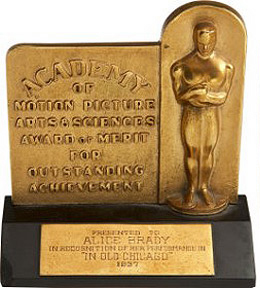
ALICE
BRADY'S OSCAR
A plaque, not a statuette.
The
prosaic point
being:
fame can evaporate faster than water
in the Mojave. In fact, it almost always
does.
Martin Scorsese's "Hugo" shone a klieg light on how
utterly forgotten
film pioneer Georges Melies was less than 20 years
after making
hundreds of ground-breaking films. And,
that's
normal, although there are rare exceptions.
The eternal fame
of a Gable or a Crawford can be traced to the fact
that people still
avidly watch their films because their
personas - against all
odds - still resonate with movie watchers. The
fame of a
Chaplin or a Pickford is more interesting.
People know of
them as historical characters, just like George
Washington or Abraham
Lincoln, not necessarily because they sit down and
enjoy the pictures
they made.
But for
most of those
who autographed "The Hollywood Hat," fame had an
expiration
date. When the movies went from silent to
talkies, lots of
big-time careers did crash. Sometimes, it was
because of their thick foreign or regional accents
and sometimes it was
because
their style of acting, perfectly appropriate for the
"silent" era,
seemed overwrought, florid, and, to be blunt, too
clunky for
talkies. Dialogue totally undercut their mojo.
It
doesn't
have to be something as catastrophic as a technical
revolution to send a career off the
tracks. There
comes a
time in most stars' careers when the public is tired
of them, when what
they have to offer no longer matches up to current
manias, tastes and
styles. When that happens, some, like Garbo or
Shearer,
retire and never look back. For all the
others, it must have
been quite painful when we, the public, muscled them
aside and just
moved on. Darwinism works in pop culture the
same way it
works elsewhere.
"The
Hollywood Hat" sprang to life in an era when all of
this drama was
first transpiring. I've lived in Los Angeles for
years now, and when I
drive around town, I see the studios, large and
small, that are still
standing and I see the 1920's Spanish-style mansions
on the windy roads
of the hills and canyons, and often think:
what was it like
back then, when all this was fresh and new and
happening for the first
time? Why can't Woody Allen do "Midnight in
Hollywood" and
send a chauffeured Duesenberg to take me back 85 or
95 years?
After
reading about all of the rollercoaster lives of the
hundreds of
people who signed the hat and how they, like Cecil
Holland,
serendipitously came to participate in the creation
of an entire
industry and art form, it certainly seems like it
was more exciting
back then.
And if I
could meet Cecil Holland, the first thing I'd say to
him is
"thanks for creating the hat, Cecil. It's been
quite an
education." And, then I'd let him do the rest
of the talking.
|